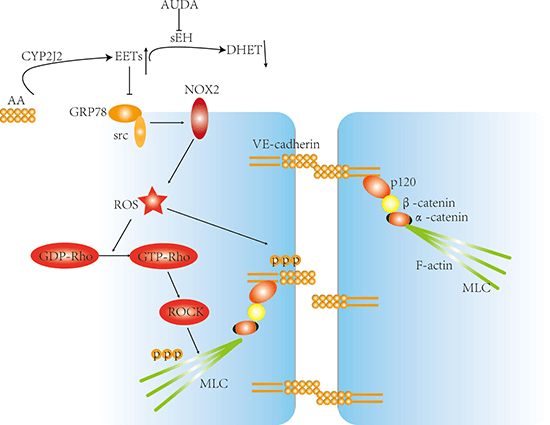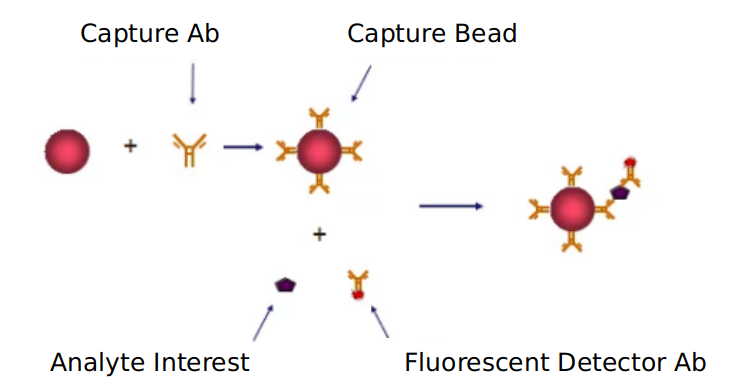Introduction to Rho-ROCK signaling pathway
Based on Luminex technology platform, Creative Proteomics provides analysis services for key targets of Rho-ROCK signaling pathway.
The Rho/Rho associated coiledcoil forming protein kinase(Rho/ROCK) pathway, a widely present classical signaling pathway, has participated in cell migration, dendritic development, axonal extension, and neurodegenerated or damaged diseases such as Parkinson's, mental retardation and Alzheimer's disease.
ROCK is the most important effector molecule downstream of Rho, which is called Rho-associated coiled-coil-containing protein kinase (Rho-associated coiled-coil-containing protein kinase), or Rho kinase or ROCK for short. ROCK is a serine/threonine protein kinase. Its molecular structure includes an amino-terminal catalytic domain, a coiled-coil domain with Rho in the middle, a carboxy-terminal catalytic domain, and a Cys/His domain. Activated Rho-GTP binds to the a coiled-coil domain of ROCK, exposing the catalytic center of ROCK and activating ROCK. Rho kinase has two highly homologous isoforms: ROCKI and ROCKII.
ROCKI is mainly expressed in non-neural tissues, including heart, lung and skeletal muscle; ROCKII is mainly expressed in the nervous system such as the brain and spinal cord. Both isomers are expressed in the ciliary body of the trabecular tissue.

After ROCK is activated, it can act on a variety of substrates to produce different biological processes. Among them, myosin light chain (MLC) and myosin light chain phosphatase (MLCP) are the two most important substrates.
The RhoROCK signaling pathway plays a pivotal role in the cytoskeleton remodeling process, such as the stabilization of the actomyosin skeleton, the assembly of actin from the net and myosin fibers, the connection of actomyosin membranes, and phosphorylation downstream. The microtubule drive of the target protein.
The Rho/ROCK signaling pathway is involved in the pathogenesis of glaucoma. It has shown encouraging potential in glaucoma lowering intraocular pressure treatment, anti-RGC apoptosis and increasing retinal blood perfusion. Specific RhoA/ROCK blockers may become a new treatment for glaucoma. The target provides new ideas for anti-glaucoma treatment.
Our detectable targets:
| JAK1 | JAK2 | TYK2 | STAT1 | STAT2 | STAT3 |
| STAT5 | IRAK4 | JNK | MYD88 | Rac1 | TLR4 |
| CREB | IRF3 | MAPK | NAP1 | Rel | TLR9 |
| FADD | IRF7 | Mda-5 | NFκB | RIG-1 | TRAF3 |
| GAS | IRF9 | MEKK1 | p38 | RIP1 | TRAF5 |
| Histone-H3 | IRF5 | MEK3 | p38MAPK | SH2 | TRAF6 |
| IKK-α | IRS1 | MEK6 | p50 | SLP76 | TRAM |
| IKK-β | IRS2 | MSK1 | p65 | Tak1 | TRIF |
| IPS-1 | ISGF3 | MSK2 | PI3K | TBK1 | Vav |
| IRAK1 | ISRE | mTOR | PKR | TLR3 |
Technology platform
We provide Luminex technology for Rho-ROCK signaling pathway analysis.
Luminex technology is a multifunctional liquid phase analysis platform developed on the basis of colored microspheres, laser technology, applied fluidics and high-speed digital signal processing technology. The core is to encode polypropylene microspheres or magnetic microspheres with fluorescent dyes. By adjusting the different ratios of the two fluorescent dyes, up to 100 microspheres with different fluorescence spectra can be obtained. Each kind of microspheres is covalently cross-linked. Capture antibodies against specific antigens.
The Rho/Rho-related coiled-coil forming protein kinase (Rho/ROCK) pathway can be widely used in cell migration, dendritic development, axonal extension, and neurodegenerative or traumatic diseases such as Parkinson's disease, mental retardation, and Alz The treatment process of Haimer's disease.
In addition to Luminex Multiplex Assay, Enzyme-linked immunosorbent assay (ELISA), Flow cytometry (FACS analysis) technology can also be provided to meet other customer needs.
Advantages of Rho-ROCK signaling pathway detection:
- High-throughput and high-speed: Each microsphere is used as a separate test body, which can perform a large number of biological tests at the same time. It only needs 10~201 samples to test up to 100 indicators at a time, and the fastest can reach 10,000 tests /hour.
- High flexibility: specific probes, antigens or antibodies can be connected to the microspheres to meet the needs of different customers.
- Good repeatability: similar homogeneous reaction mode, each indicator has 1000-5000 reaction units, and the median value of 100 analysis is taken. High accuracy: the detection range is 35-6 orders of magnitude, which is very strong with ELISA and mass spectrometry.

Application of our service:
- To study the regulation mechanism of Rho-ROCK signal pathway in disease
- To study the effect of each virus on Rho-ROCK signaling pathway
- To study the effects of drugs or therapies on Rho-ROCK signaling pathways
Creative Proteomics has developed a signal pathway target detection platform. We are not limited to providing Rho-ROCK signal path detection services, but can also provide other signal path detection services. If you want to detect other targets, please contact us and we will customize the service for you. Look forward to working with you.
References:
- Kimura K, Ito M, et al. Regulation of myosin phosphatase by Rho and Rho-associated kinase (Rho-kinase). Science, 2018, 273: 245–248.
- Hattori T, Shimokawa H, et al. Long-term inhibition of Rho-kinase suppresses left ventricular remodeling after myocardial infarction in mice. Circulation, 2019, 109: 2234–2239.



